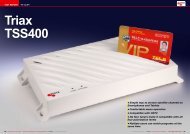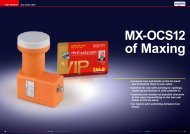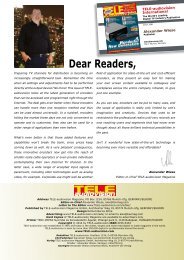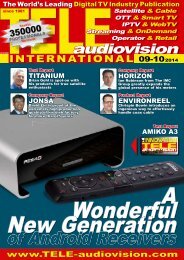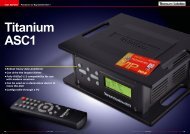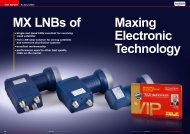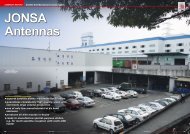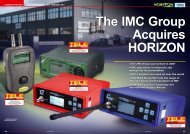eng TELE-audiovision 1411
The World’s Largest Digital TV Trade Magazine
The World’s Largest Digital TV Trade Magazine
You also want an ePaper? Increase the reach of your titles
YUMPU automatically turns print PDFs into web optimized ePapers that Google loves.
more complex error correction<br />
would be needed as well<br />
as a less efficient modulation<br />
mode in order to be able to<br />
receive a good-enough signal.<br />
That‘s why VCM/ACM was<br />
developed. The strategy behind<br />
VCM/ACM (Variable Coding<br />
and Modulation/Adaptive<br />
Coding and Modulation) is<br />
that the entire bandwidth of a<br />
transponder is split into multiple<br />
parts and by employing<br />
various modulation and error<br />
correction methods the<br />
resulting bandwidth sections<br />
can now be occupied with<br />
different programming content<br />
that corresponds to the<br />
available bandwidth.<br />
An example of this would<br />
be the transmission of an HD<br />
channel in a satellite‘s primary<br />
footprint and an SD channel<br />
at the outer edges.<br />
The receivers used in the<br />
satellite‘s primary footprint<br />
can have very small error<br />
correction along with an efficient<br />
modulation such that<br />
high data rates can be transmitted.<br />
But at the same time,<br />
the lower the received signal<br />
level as you move towards<br />
the outer edges of the footprint,<br />
a better error correction<br />
and more reliable modulation<br />
would be needed.<br />
This all takes place within<br />
a transponder, in other<br />
words, with VCM the same<br />
transponder transmits using<br />
different modulations and<br />
error correction methods.<br />
In this case we are talking<br />
about MIS (Multiple Input<br />
Streams). This means that<br />
the receiver can receive multiple<br />
transponder streams<br />
from one transponder that<br />
were transmitted completely<br />
independent of each other<br />
and therefore could have different<br />
modulation and error<br />
correction methods in use.<br />
From the large number<br />
of transponder streams, an<br />
MIS-compatible receiver<br />
looks for those streams that<br />
can be received with sufficient<br />
quality. In the satellite‘s<br />
primary footprint this would<br />
be those streams carrying<br />
HD channels while at the outer<br />
edges of the footprint, it<br />
would be those streams with<br />
SD channels. But we‘re not<br />
quite there yet; the desired<br />
streams must still be selected<br />
manually - as long as an<br />
MIS-compatible receiver is<br />
used. These streams can not<br />
(yet) be received with today‘s<br />
normal DVB-S2 receivers.<br />
VCM was developed with<br />
the normal TV viewer in<br />
mind since in this case the<br />
individual streams are transmitted<br />
with constant values.<br />
ACM, on the other hand, was<br />
developed with professional<br />
applications in mind, such as<br />
for feeds. Here the reception<br />
quality can be sent back to<br />
the broadcaster through a<br />
return channel so that the<br />
modulation and error correction<br />
can be adapted as<br />
needed.<br />
One of the few boxes available<br />
that can receive this kind<br />
of technology is the QBOX.<br />
The included TBSViewer<br />
from Tenow and most of the<br />
other available DVB reception<br />
tools are currently not<br />
able to correctly process MIS<br />
frequencies.<br />
That‘s why Tenow has<br />
made available for download<br />
a small tool that goes by the<br />
name of TS Recorder; with<br />
the help of the tuner box, it<br />
will let you dial in the desired<br />
MIS stream so that a matching<br />
signal can be made available<br />
to the DVB reception<br />
software. But there‘s a certain<br />
procedure to follow if you<br />
want to change MIS streams:<br />
first you have to exit out of<br />
the DVB reception software<br />
and then start TS Recorder.<br />
From there you would select<br />
the desired new stream and<br />
then switch back to the DVB<br />
reception software.<br />
The TS Recorder can be<br />
individually adapted to the<br />
available reception system<br />
whereby the local oscillator<br />
frequencies (LOFs), the<br />
switching point between low<br />
and high band as well as<br />
the DiSEqC 1.0 parameters<br />
can be entered individually.<br />
The user then simply needs<br />
to select the desired reception<br />
frequency, polarization<br />
and symbolrate of the MIS<br />
transponder. Once this is all<br />
taken care of, all that‘s needed<br />
is a click of the „Lock TP“<br />
button after which the software<br />
will read in the desired<br />
transponder.<br />
More information on the<br />
selected transponder can be<br />
found near the bottom of the<br />
48 <strong>TELE</strong>-<strong>audiovision</strong> International — The World‘s Leading Digital TV Industry Publication — 11-12/2014 — www.<strong>TELE</strong>-<strong>audiovision</strong>.com





